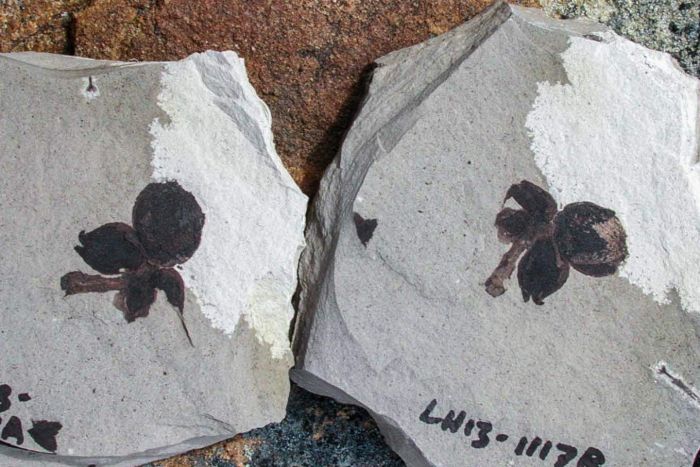“It’s like finding a polar bear in Antarctica,” Professor Wilf said.
Rainforest once covered the plains of Patagonia where the fossils were found. (Supplied: Peter Wilf, Penn State University)
Professor Wilf and colleagues argue while the ancestors of the ancient beech tree may have come from North America, the genus Castanopsis
itself evolved in the wet forests of the southern Gondwana supercontinent, which included South America, Antarctica and Australia.
From there, the tree most likely hitched a ride on Australia when it broke off from Antarctica and drifted north, the researchers say.
This would have been just in time, because the ice age that followed killed off a lot of forests that were too far south.
“Australia was the sort of life raft when Gondwana broke up,” Professor Wilf said.
This Gondwanan pathway has been established for lots of other species shared between South America and Australia.
The great escape
Plant ecologist Robert Kooyman from Macquarie University described the rescue of Gondwanan plant refugees by Australia as “one of the greatest biological escape stories of all time”.
Leaves from a living species of Castanopsis. (Supplied: Peter Wilf, Penn State University)
To add to the challenge, Australia was drying out as it drifted away from Antarctica, which meant many Gondwanan plants ended up seeking refuge further north.
The newly uplifted mountains of New Guinea that formed when Australia collided with Asia provided the perfect refuge for some, said Dr Kooyman, who was not an author on the new paper but has published papers with Dr Wilf before.
He agreed that Castanopsis was likely one of those plants that made the journey with Australia — “with the ice age nipping at its heels” — before escaping further north as the continent dried out.
“It’s an extraordinary tale really … A breathtaking slow-motion escape.”
Professor Wilf said it had taken him and colleagues from Argentina decades of work at Laguna del Hunco to establish conclusively the presence of the tree in Patagonia.
The clincher was finding “fruiting spikes”, one of which was 15 centimetres long with 110 immature fruit arranged in a pattern that was unmistakably from the genus Castanopsis.
A close up of part of the fruiting spike, which had 110 immature fruit on it. (Supplied: Peter Wilf, Penn State University)
The baby fruits also preserved delicate flower parts that were used to class it in that genus.
Professor Wilf said it was a rare discovery, given it’s much more common to find fossil leaves.
“We got two fruiting spikes out of 8,000 fossils that we’ve collected from this place over 20 years from extremely hard rocks that are very hard to split open,” he said.
“And what a find. The preservation is just incredible.”
Interpretation challenged
Palaeobotanist Robert Hill of the University of Adelaide said the fossils were “wonderful” and good evidence the beech tree family was in South America about 52 million years ago.
But he thought Professor Wilf and colleagues were “overinterpreting” the discovery as evidence that Castanopsis evolved in Patagonia and then caught the Australian life raft.
Professor Hill said Laguna del Hunco had been a key source of fossils that have helped reveal the Gondwana legacy of plants in Australia and beyond.
An immature fruit of a Castanopsis that now lives in New Guinea. (Supplied: Peter Wilf, Penn State University)
But he did not think the site was old enough to provide evidence of where the group of trees evolved.
“Just because you find a string of good fossils doesn’t turn it into the garden of Eden.”
And if Castanopsis did hitch a ride north on Australia, then where is the fossil evidence, asks Professor Hill?
“We’ve looked at many tens of thousands of plant fossils in Australia from the right time and we’ve never seen this family here,” he said, adding it had also never been picked up in Antarctica.
Professor Hill argued the odds are against this genus of tree coming from the south and it was “at least equally likely” that its family reached down to South America and Asia from the northern hemisphere.
One of the ancient beech tree leaves. (Supplied: Peter Wilf, Penn State University)
Palaeobotanist Raymond Carpenter, who works with Professor Hill at the University of Adelaide and has worked with Professor Wilf too, also remains to be convinced Castanopsis took the Gondwanan pathway.
But he said evidence of the tree could have been overlooked in Australia, not least because its family was believed never to have made it this far south.
“Nobody was expecting them, so nobody was looking for them,” said Dr Carpenter.
He said genetic evidence might one day be useful in estimating the age of the Castanopsis genus in New Guinea and providing support or otherwise for the life raft theory.
But for now Professor Wilf believes there are “no other plausible hypotheses” to explain how the group of trees got to New Guinea and beyond.
“We don’t really know how else it could have got to South-East Asia.”
And, he suggests, it is just a matter of time before fossil evidence is found in Australia.
As part of his argument, Professor Wilf pointed to the fact that these Patagonian fossils were found with a whole slew of other plants that are accepted as having taken the Gondwanan pathway, including Australia’s beloved eucalyptus .
“It’s an extraordinary thing that you can go to South America, split a rock and find all these things you find in the mountains of New Guinea on the same slab.”
Source:
ABC Science. Article By Anna Salleh
@WFS,World Fossil Society, Riffin T Sajeev,Russel T sajeev




 June 7th, 2019
June 7th, 2019  Riffin
Riffin  Posted in
Posted in  Tags:
Tags: 
I got what you intend,saved to bookmarks, very decent site.